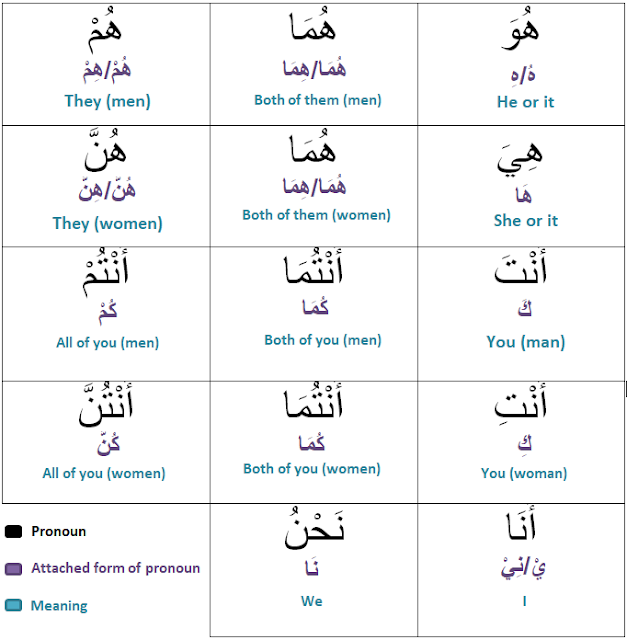Arabic present tense - fi'l mudhaari'
The chart
above shows the usual pattern of words used in the present tense of the Arabic
language. Present tense works quite the same way as the past tense. When we use
present tense in English, the verb will usually come with a pronoun. For
example, ‘he sleeps’, ‘she helps’, ‘they come’ etc…But in
Arabic, the pronoun will be hidden in the verb. The words in grey show the
hidden pronoun. (inside doer)
So for
example if you say يَكْتُبُ, that by itself would mean ‘he
writes’. If you say يَنْصُرُ that would mean ‘he helps’. It
depends on the pattern of the word. Hence it is helpful to memorize this chart
and be familiar with the pattern. So that when you see for instance a word like
نَكْتُبُ you would be able to recognize that
the hidden pronoun is نَحْنُ and translate it as ‘we write.’
Moreover, if
you are familiar with the pattern of this chart, you will be able to recite the
pattern for any word given. For example if I say يَنْصُرُ
you would be able to recite and know the all the meanings in the whole chart as
‘huwa yansuru’ (he helps), ‘humaa yansuraani’ (both of them (m) help), ‘hum
yansuroona’ (they (m) help) and so on.
As you can
notice, some verbs in this chart are same for some pronouns. We only get to
know what it means depending on the place where the word is used in a text. It’s
also helpful to know that some words begin with ي
while some begin with ت. Identifying those will help
in the memorization of the chart. The unique beginnings are only for the verbs
of أَنَا and نَحْنُ.
Verb of أَنَا begins with أَ
and verb of نَحْنُ begins with نَ.
Mental
exercise:
Recite the
past tense chart for the following words and think of the words’ meanings. Read each word, say the meaning and then say
the next word.
يَنْصُرُ (he helps)
يَعْمَلُ (he works)
يَجْعَلُ (he makes)
*Lesson based on a lesson of ‘Arabic with Husna’ by Ustadh
Nouman
**************************************************************************
މަތީގައިވާ ތާވަލުން ދައްކައިދެނީ ޢަރަބި ބަހުގައި ވޭވޭހުރިކަމަށް
ޢާއްމުގޮތެއްގައި ބޭނުންކުރެވޭ ބަސްތައް ހުންނަ ގޮތެވެ. ދިވެހި ބަހުގައި
ޢާއްމުގޮތެއްގައި ވޭވޭހުރިކަމެއް ބުނެވޭ ނަމަ އޭތި އަންނާނީ ކަންކުރާ މީހާއާއި
އެކީގައެވެ. މިސާލަކަށް 'އޭނަ ނިދައެވެ.'، 'އެމީހުން އާދެއެވެ.'، 'އަހަރުމެން
އެހީވަމެވެ.' އެހެނަސް ޢަރަބި ބަހުގައި ކަމެއް (ފިޢްލް) އެއް ބުނެވޭއިރު އެ ބަހުގެ
ތެރޭގައި ކަންކުރާ މީހާ އޮންނާނީ ފޮރުވިފައެވެ. ތާވަލުގައި އަޅިކުލައިން ފެންނަމުން
އެދަނީ ކޮންމެ ބަހެއްގައި ފޮރުވިފައިވި ޟަމީރެވެ. (ޟަމީރްގެ ފިލާވަޅު ބައްލަވާ)
މިސާލަކަށް ހަމައެކަނި يَكْتُبُ ކިޔައިފިނަމަ
އެއަށް އިތުރު ބަހެއް އެއްނުކުރިޔަސް އޭގެ މާނައަކީ 'އޭނަ ލިޔައެވެ.' يَنْصُرُ ކިޔައިފިނަމަ އޭގެ
މާނައަކީ 'އޭނަ އެހީވެއެވެ.' މާނަ އެނގޭނީ ބަހުގެ އަޑަށް ވިސްނުމުންނެވެ. އެހެންކަމުން
މި ތާވަލު ހިތުދަސްކޮށް މި ބަސްތަކުގެ އަޑުތަކަށް ފަރިތަވުމުން ވަރަށް
ފަސޭހަވެގެންދާނެއެވެ. އެހެނީ މިސާލަކަށް ތިބާއަށް نَكْتُبُ ފަދަ ބަހެއް
ފެނުނިއްޔާ ވަގުތުން އޭގެ ތެރޭގައި ފޮރުވިފައިވި ޟަމީރަކީ نَحْنُ
ކަން އެނގި އޭތި 'އަހަރުމެން ލިޔަމެވެ.'
ގެ ގޮތުގައި ތަރުޖަމާ ކުރެވިދާނެއެވެ.
މީގެ އިތުރުން މި ބަސްތަކުގެ އަޑުތަކަށް ތިބާ ފަރިތަ
ވެއްޖެނަމަ ކޮންމެ ބަހަކަށް ވެސް ތިބާއަށް މި ތާވަލާއި އެއްގޮތަށް ބަސްތައް ހެދި
އެ ބަސްތަކުގެ މާނަ ނަގައިގަނެވޭނެއެވެ. މިސާލަކަށް އަޅުގަނޑު يَنْصُرُ
އޭ ތިބާ ގާތު ބުނެފިނަމަ އެ ބަސް
މުޅި ތާވަލަށް ފައްތައި ތިބާއަށް ބަސްތަކެއް ހަދައި އެ ބަސްތަކުގެ މާނަ ނަގައި
ގަނެވޭނެއެވެ. މިކަހަލަ ގޮތަކަށެވެ. 'ހުވަ ޔަންޞުރު' (އޭނަ (ފ) އެހީވިއެވެ.)، ހުމާ
ޔަންޞުރާނި (އެދެމީހުން (ފ) އެހީވިއެވެ.)، 'ހުމް ޔަންޞުރޫނަ' (އެމީހުން (ފ)
އެހީވިއެވެ.)
މި ތާވަލުގައި ބައެއް ބަސްތައް އެއްގޮތްކަން ތިބާއަށް
ފާހަގަ ކުރެވިދާނެއެވެ. އެ ބަސްތައް ލިޔުމަކުން ފެނުމުން މާނަކުރަން އެނގޭނީ ބަސް
ބޭނުންކުރެވިފައިވި ތަން އެނގުމުންނެވެ. އަދި މި ތާވަލުގައި ގިނަ ބަސްތައް
ފެށިފައިވަނީ 'ޔާ' އިންނާއި 'ތާ' އިން ކަން ފާހަގަކުރެވޭނެއެވެ. އެއީ ކޮން
ބަސްތަކެއްކަން ފާހަގަކުރުމުން މި ތާވަލު ނުބަލައި ދަސްކުރަން ފަސޭހަ ވާނެއެވެ.
ތަފާތު ފެށުމެއް ލިބިފައިވީ 'އަނަ' އަދި'ނަޙްނު' ގެ ފިޢްލް ތަކަށް ކަން ތިބާއަށް
ފާހަގަ ވާނެއެވެ. 'އަނަ' ގެ ފިޢްލް އަލިފް އިން ފެށިފައިވީއިރު 'ނަޙްނު' ގެ ފިޢްލް
ފެށިފައިވަނީ ނޫނަކުންނެވެ.
ފަރިތަކުރުން:
ތިރީގައިވި ކޮންމެ ބަހެއް މި ތާވަލަށް ފައްތައި އެ
ބަސްތަކުގެ މާނައާމެދު ވިސްނާށެވެ. ކޮންމެ ބަހެއް ކިޔާފައި އޭގެ މާނަ ކިޔާފައި
އަނެއްބަސް ކިޔާށެވެ.
يَنْصُرُ (އޭނަ (ފ) އެހީވެއެވެ)
يَعْمَلُ (އޭނަ (ފ)
މަސައްކަތް ކުރެއެވެ.
يَجْعَلُ (އޭނަ (ފ) ހަދައެވެ)
*ޢަރަބިކް ވިތް ޙުސްނާގެ ފިލާވަޅަކަށް ބިނާކުރެވިފައިވި
ފިލާވަޅެއް




Comments
Post a Comment